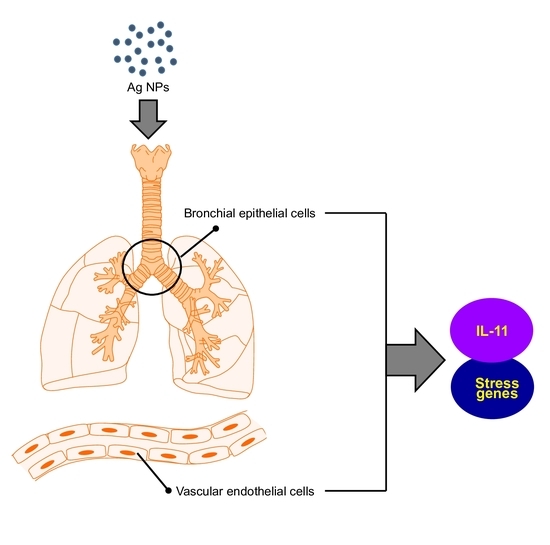Increased Interleukin-11 and Stress-Related Gene Expression in Human Endothelial and Bronchial Epithelial Cells Exposed to Silver Nanoparticles
Abstract
1. Introduction
2. Materials and Methods
2.1. Silver NPs
2.2. Characterization of Silver NPs
2.3. Cell Lines and Culture
2.4. Analysis of Cell Proliferation
2.5. Cytokine Detection
2.6. Real-Time Reverse Transcription Polymerase Chain Reaction (RT-PCR)
2.7. Western Blotting
2.8. TEM Analysis
2.9. RNA Isolation and cDNA Microarray Analysis
2.10. Statistical Analysis
3. Results
3.1. Characterization of Silver NPs
3.2. Cytotoxicity in Endothelial and Epithelial Cells
3.3. cDNA Microarray Analysis
3.4. Classification of Genes That Showed Increased Expression Following Treatment with Silver NPs
3.5. Effects of Silver NPs on Cytokine Production and Inflammatory Response
3.6. Expression of Genes Related to Cytokine Production and ROS
3.7. Effects of Silver NPs on HSP-70 and HO-1 Expression
3.8. Intracellular Localization of Silver NPs
4. Discussion
5. Conclusions
Supplementary Materials
Author Contributions
Funding
Institutional Review Board Statement
Informed Consent Statement
Data Availability Statement
Conflicts of Interest
References
- Whitesides, G.M.; Mathias, J.P.; Seto, C.T. Molecular self-assembly and nanochemistry: A chemical strategy for the synthesis of nanostructures. Science 1991, 254, 1312–1319. [Google Scholar] [CrossRef]
- Saz, M.C. Toxicologic Evaluation of Silver Nanoparticles. Ph.D. Thesis, Hacettepe University, Ankara, Turkey, 2014. [Google Scholar]
- Huang, C.; Notten, A.; Rasters, N. Nanoscience and technology publications and patents: A review of social science studies and search strategies. J. Technol. Transf. 2010, 36, 145–172. [Google Scholar] [CrossRef]
- Tran, Q.H.; Nguyen, V.Q.; Le, A.-T. Corrigendum: Silver nanoparticles: Synthesis, properties, toxicology, applications and perspectives (Adv. Nat. Sci: Nanosci. Nanotechnol. 4 033001). Adv. Nat. Sci. Nanosci. Nanotechnol. 2018, 9, 049501. [Google Scholar] [CrossRef]
- Stevenson, A.P.; Bea, D.B.; Civit, S.; Contera, S.; Cerveto, A.I.; Trigueros, S. Three strategies to stabilise nearly monodispersed silver nanoparticles in aqueous solution. Nanoscale Res. Lett. 2012, 7, 151. [Google Scholar] [CrossRef]
- Wu, J.T.; Wu, L.L. Linking inflammation and atherogenesis: Soluble markers identified for the detection of risk factors and for early risk assessment. Clin. Chim. Acta 2006, 366, 74–80. [Google Scholar] [CrossRef] [PubMed]
- Lim, D.-H.; Jang, J.; Kim, S.; Kang, T.; Lee, K.; Choi, I.H. The effects of sub-lethal concentrations of silver nanoparticles on inflammatory and stress genes in human macrophages using cDNA microarray analysis. Biomaterials 2012, 33, 4690–4699. [Google Scholar] [CrossRef]
- Taga, T.; Kishimoto, T. gp130 and the Interleukin-6 Family of Cytokines. Annu. Rev. Immunol. 1997, 15, 797–819. [Google Scholar] [CrossRef]
- Putoczki, T.L.; Thiem, S.; Loving, A.; Busuttil, R.A.; Wilson, N.J.; Ziegler, P.K.; Nguyen, P.M.; Preaudet, A.; Farid, R.; Edwards, K.M.; et al. Interleukin-11 Is the Dominant IL-6 Family Cytokine during Gastrointestinal Tumorigenesis and Can Be Targeted Therapeutically. Cancer Cell 2013, 24, 257–271. [Google Scholar] [CrossRef]
- Schwertschlag, U.S.; Trepicchio, W.L.; Dykstra, K.H.; Keith, J.; Turner, K.J.; Dorner, A.J. Hematopoietic, immunomodulatory and epithelial effects of interleukin-11. Leukemia 1999, 13, 1307–1315. [Google Scholar] [CrossRef] [PubMed]
- Wan, B.; Zhang, H.; Fu, H.; Chen, Y.; Yang, L.; Yin, J.; Wan, Y.; Shi, Y. Recombinant human interleukin-11 (IL-11) is a protective factor in severe sepsis with thrombocytopenia: A case-control study. Cytokine 2015, 76, 138–143. [Google Scholar] [CrossRef] [PubMed]
- Putoczki, T.L.; Ernst, M. More than a sidekick: The IL-6 family cytokine IL-11 links inflammation to cancer. J. Leukoc. Biol. 2010, 88, 1109–1117. [Google Scholar] [CrossRef]
- Du, X.; Wanc, C.; Lee, W.-H.; Yang, Z.; Williams, D.A. Murine Interleukin-11 (IL-11) Is Expressed at High Levels in the Hippocampus and Expression Is Developmentally Regulated in the Testis. J. Cell. Physiol. 1996, 168, 362–372. [Google Scholar] [CrossRef]
- Du, X.; Williams, D.A. Interleukin-11: Review of Molecular, Cell Biology, and Clinical Use. Blood 1997, 89, 3897–3908. [Google Scholar] [CrossRef]
- Musashi, M.; Yang, Y.C.; Paul, S.R.; Clark, S.C.; Sudo, T.; Ogawa, M. Direct and synergistic effects of interleukin 11 on murine hemopoiesis in culture. Proc. Natl. Acad. Sci. USA 1991, 88, 765–769. [Google Scholar] [CrossRef]
- Hill, G.R.; Cooke, K.R.; Teshima, T.; Crawford, J.M.; Keith, J.C.; Brinson, Y.S.; Bungard, D.; Ferrara, J.L. Interleukin-11 promotes T cell polarization and prevents acute graft-versus-host disease after allogeneic bone marrow transplantation. J. Clin. Investig. 1998, 102, 115–123. [Google Scholar] [CrossRef] [PubMed]
- Howlett, M.; Chalinor, H.V.; Buzzelli, J.N.; Nguyen, N.; Van Driel, I.R.; Bell, K.M.; Fox, J.G.; Dimitriadis, E.; Menheniott, T.R.; Giraud, A.S.; et al. IL-11 is a parietal cell cytokine that induces atrophic gastritis. Gut 2011, 61, 1398–1409. [Google Scholar] [CrossRef] [PubMed]
- Xu, D.H.; Zhu, Z.; Wakefield, M.R.; Xiao, H.; Bai, Q.; Fang, Y. The role of IL-11 in immunity and cancer. Cancer Lett. 2016, 373, 156–163. [Google Scholar] [CrossRef]
- Park, E.-J.; Bae, E.; Yi, J.; Kim, Y.; Choi, K.; Lee, S.H.; Yoon, J.; Lee, B.C.; Park, K. Repeated-dose toxicity and inflammatory responses in mice by oral administration of silver nanoparticles. Environ. Toxicol. Pharmacol. 2010, 30, 162–168. [Google Scholar] [CrossRef] [PubMed]
- Novotny, J.A.; Green, M.H.; Boston, R.C. (Eds.) Mathematical Modeling in Nutrition and the Health Sciences. In Taurine 6; Springer Nature: Boston, MA, USA, 2003; Volume 537. [Google Scholar]
- Xin, L.; Wang, J.; Wu, Y.; Guo, S.; Tong, J. Increased oxidative stress and activated heat shock proteins in human cell lines by silver nanoparticles. Hum. Exp. Toxicol. 2015, 34, 315–323. [Google Scholar] [CrossRef]
- Beer, C.; Foldbjerg, R.B.; Hayashi, Y.; Sutherland, D.S.; Autrup, H. Toxicity of silver nanoparticles—Nanoparticle or silver ion? Toxicol. Lett. 2012, 208, 286–292. [Google Scholar] [CrossRef]
- Negahdaripour, M.; Nezafat, N.; Ghasemi, Y. A panoramic review and in silico analysis of IL-11 structure and function. Cytokine Growth Factor Rev. 2016, 32, 41–61. [Google Scholar] [CrossRef] [PubMed]
- Mahboubi, K.; Li, F.; Plescia, J.; Kirkiles-Smith, N.C.; Mesri, M.; Du, Y.; Carroll, J.M.; Elias, J.A.; Altieri, D.C.; Pober, J.S. Interleukin-11 Up-Regulates Survivin Expression in Endothelial Cells through a Signal Transducer and Activator of Transcription-3 Pathway. Lab. Investig. 2001, 81, 327–334. [Google Scholar] [CrossRef][Green Version]
- Ernst, M.; Putoczki, T.L. Molecular Pathways: IL11 as a Tumor-Promoting Cytokine—Translational Implications for Cancers. Clin. Cancer Res. 2014, 20, 5579–5588. [Google Scholar] [CrossRef] [PubMed]
- Johnstone, C.N.; Chand, A.; Putoczki, T.L.; Ernst, M. Emerging roles for IL-11 signaling in cancer development and progression: Focus on breast cancer. Cytokine Growth Factor Rev. 2015, 26, 489–498. [Google Scholar] [CrossRef] [PubMed]
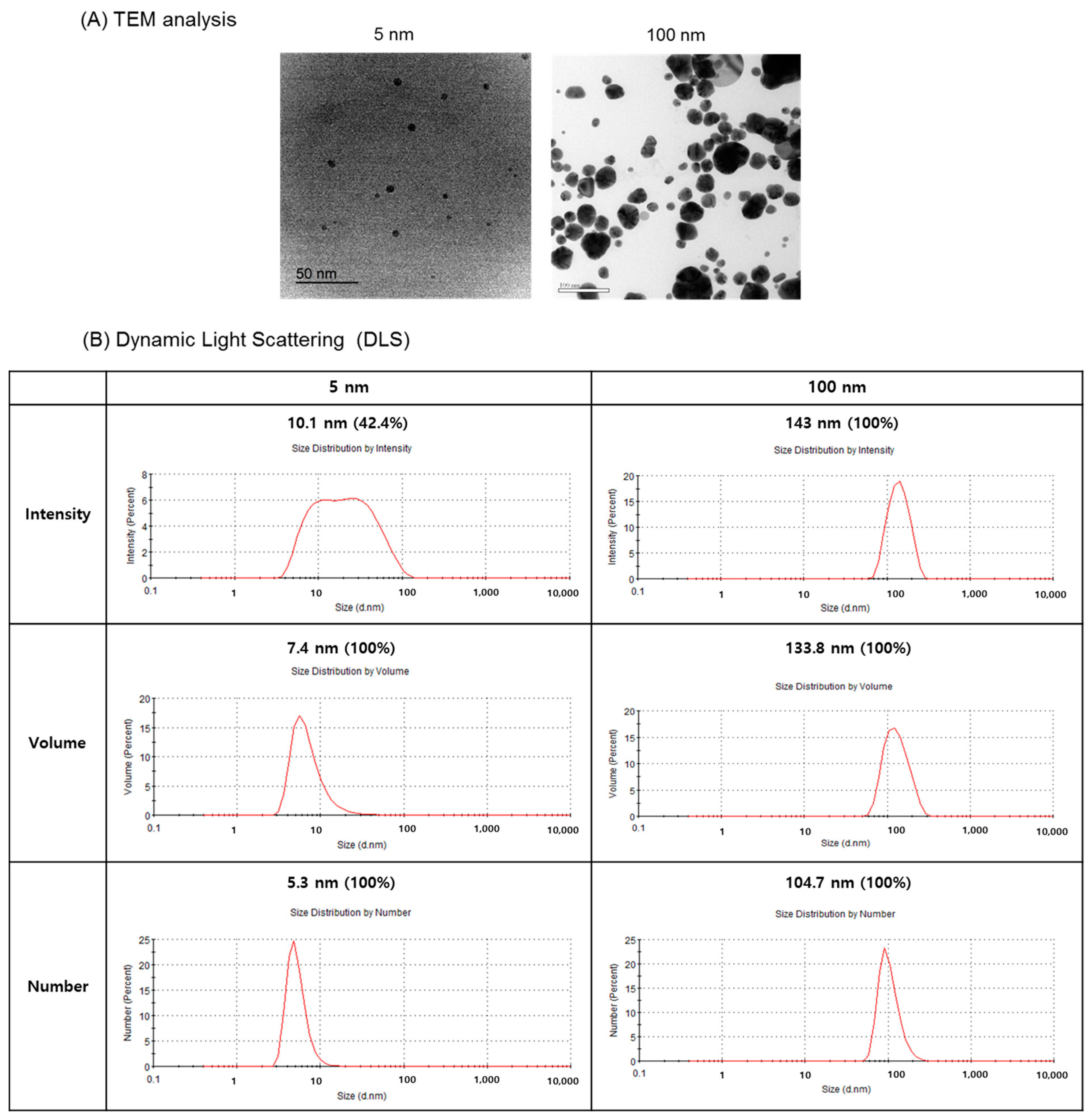


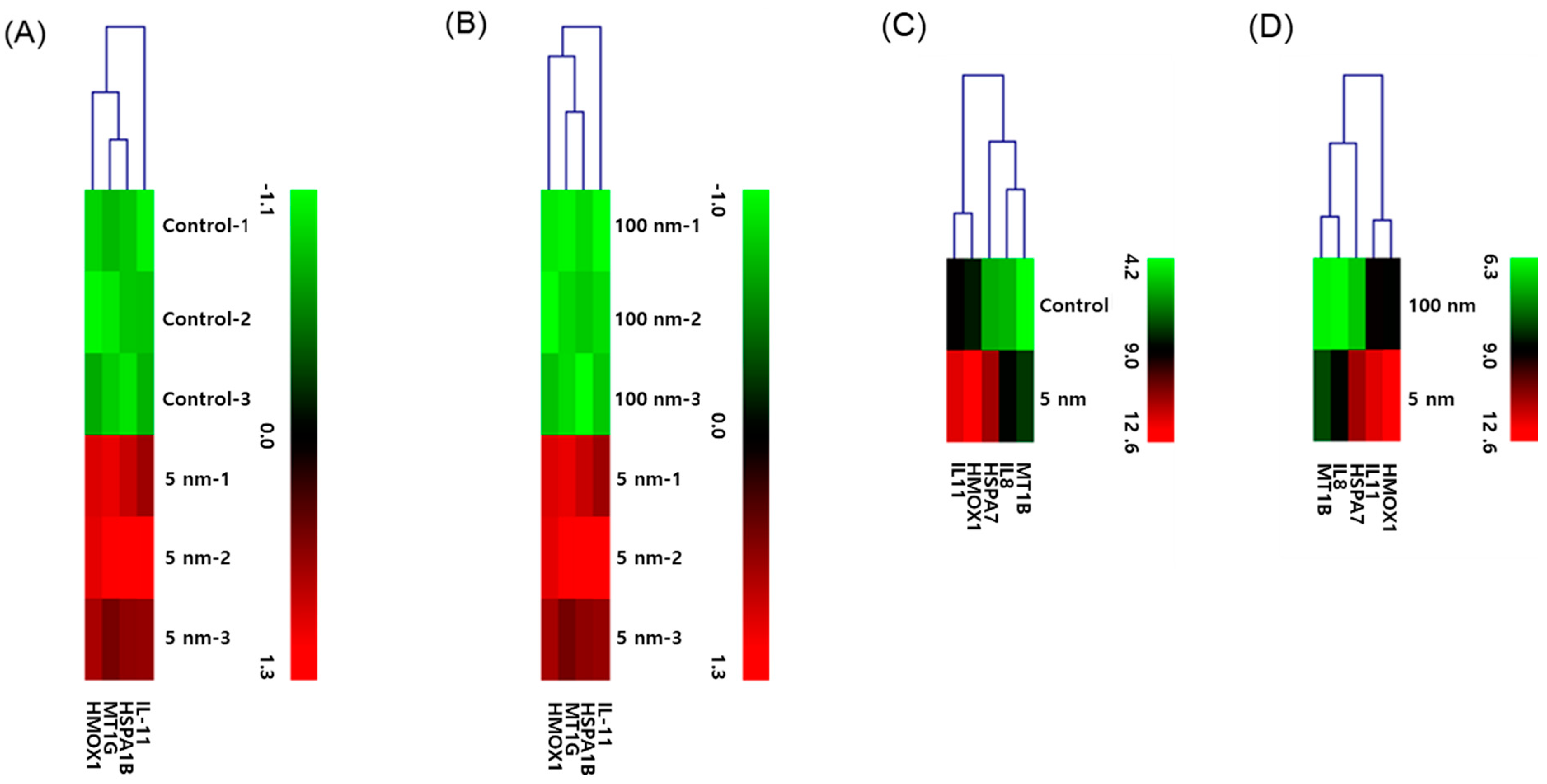


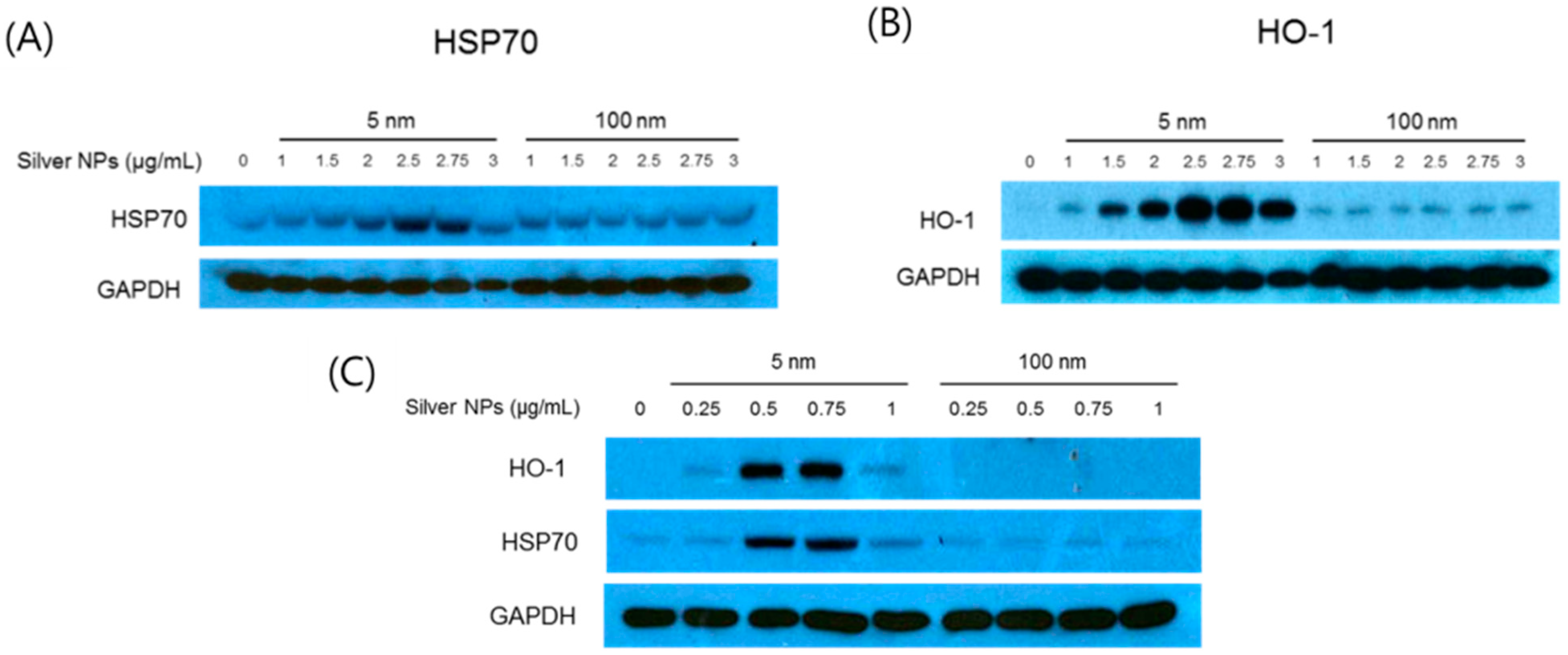
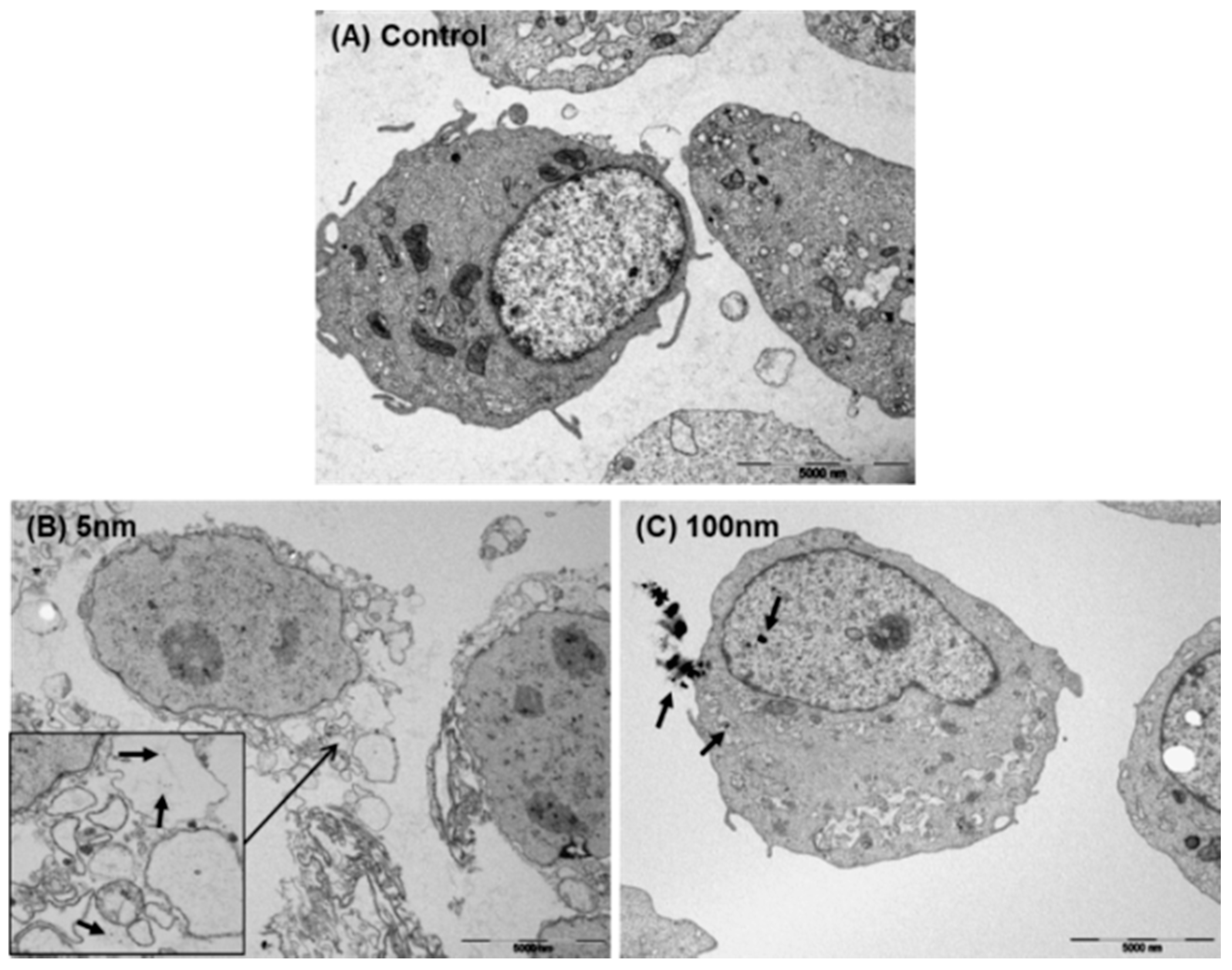
| Group | EA. hy926 1 | BEAS-2B 2 | ||||
|---|---|---|---|---|---|---|
| Up-Regulation | Down-Regulation | Total Genes | Up-Regulation | Down-Regulation | Total Genes | |
| Control vs. 5 nm | 466 | 193 | 659 | 726 | 242 | 968 |
| Control vs. 100 nm | 27 | 20 | 47 | 39 | 55 | 94 |
| 100 nm vs. 5 nm | 479 | 181 | 660 | 821 | 251 | 1072 |
| (A) Control vs. 5 nm | ||
| Genes | Fold Change | p-Value |
| metallothionein 1G | 47.9 | 0.0008 |
| long intergenic non-protein coding RNA 622 | 15.1 | 0.0079 |
| heme oxygenase (decycling) 1 | 13.3 | 0.0001 |
| putative novel transcript | 11.3 | 0.0189 |
| interleukin 11 | 10.4 | 0.0015 |
| matrix metallopeptidase 10 (stromelysin 2) | 8.7 | 0.0040 |
| chemokine (C-X-C motif) ligand 8 | 6.1 | 0.0045 |
| heat shock 70 kDa protein 1B | 5.1 | 0.0004 |
| heat shock 70 kDa protein 6 (HSP70B) | 4.8 | 0.0027 |
| metallothionein 1E | 4.6 | 0.0008 |
| interleukin 36, alpha | 4.6 | 0.0292 |
| heat shock 70 kDa protein 1A | 4.0 | 0.0006 |
| interleukin 13 receptor, alpha 2 | 3.8 | 0.0474 |
| heat shock 70 kDa protein 9 (mortalin) | 3.5 | 0.0082 |
| interleukin 1 receptor-like 1 | 3.1 | 0.0080 |
| interleukin 7 receptor | 2.7 | 0.0143 |
| interleukin 1, alpha | 2.6 | 0.0215 |
| vascular endothelial growth factor A | 2.4 | 0.0283 |
| metallothionein 1X | 2.3 | 0.0019 |
| metallothionein 1F | 2.2 | 0.0379 |
| (B) 100 nm vs. 5 nm | ||
| Genes | Fold Change | p-value |
| metallothionein 1G | 44.3 | 0.0008 |
| long intergenic non-protein coding RNA 622 | 18.1 | 0.0061 |
| putative novel transcript | 13.8 | 0.0140 |
| heme oxygenase (decycling) 1 | 11.5 | 0.0001 |
| interleukin 11 | 11.0 | 0.0013 |
| nuclear receptor subfamily 4, group A, member 1 | 7.9 | 0.0003 |
| matrix metallopeptidase 10 (stromelysin 2) | 7.8 | 0.0028 |
| chemokine (C-X-C motif) ligand 8 | 6.4 | 0.0008 |
| heat shock 70 kDa protein 6 (HSP70B) | 5.2 | 0.0026 |
| heat shock 70 kDa protein 1B | 5.0 | 0.0005 |
| metallothionein 1E | 4.3 | 0.0008 |
| interleukin 36, alpha | 4.0 | 0.0391 |
| heat shock 70 kDa protein 9 (mortalin) | 3.9 | 0.0042 |
| heat shock 70 kDa protein 1A | 3.9 | 0.0008 |
| interleukin 13 receptor, alpha 2 | 3.5 | 0.0479 |
| interleukin 1 receptor-like 1 | 2.8 | 0.0108 |
| spermine oxidase | 2.8 | 0.0069 |
| vascular endothelial growth factor A | 2.6 | 0.0228 |
| interleukin 1, alpha | 2.6 | 0.0191 |
| metallothionein 1X | 2.3 | 0.0010 |
| (A) Control vs. 5 nm | |
| Genes | Fold Change |
| activity-regulated cytoskeleton-associated protein | 46.1 |
| heat shock 70 kDa protein 7 (HSP70B) | 36.4 |
| heme oxygenase (decycling) 1 | 18.1 |
| metallothionein 1B | 12.8 |
| metallothionein 1E | 12.7 |
| heat shock 70 kDa protein 6 (HSP70B’) | 11.1 |
| interleukin 8 | 9.8 |
| metallothionein 1G | 6.8 |
| interleukin 11 | 6.2 |
| interleukin 1 receptor-like 1 | 5.4 |
| metallothionein 1M | 5.1 |
| heat shock 70 kDa protein 1B | 4.2 |
| BCL2-associated athanogene 3 | 3.7 |
| heat shock 70 kDa protein 1A | 3.5 |
| cytochrome P450, family 4, subfamily F, polypeptide 11 | 3.4 |
| heat shock 70 kDa protein 9 (mortalin) | 3.4 |
| VGF nerve growth factor inducible | 3.1 |
| oxidative stress responsive serine-rich 1 | 2.7 |
| heparin-binding EGF-like growth factor | 2.6 |
| Smad nuclear interacting protein 1 | 2.4 |
| (B) 100 nm vs. 5 nm | |
| Genes | Fold Change |
| activity-regulated cytoskeleton-associated protein | 48.0 |
| heat shock 70 kDa protein 7 (HSP70B) | 28.9 |
| heme oxygenase (decycling) 1 | 12.6 |
| interleukin 8 | 11.5 |
| heat shock 70 kDa protein 6 (HSP70B’) | 9.9 |
| metallothionein 1G | 6.0 |
| interleukin 11 | 6.0 |
| metallothionein 1B | 5.4 |
| interleukin 1 receptor-like 1 | 5.4 |
| metallothionein 1E | 4.7 |
| heat shock 70 kDa protein 1-like | 4.5 |
| heat shock 70 kDa protein 1B | 4.4 |
| metallothionein 1M | 3.8 |
| heat shock 70 kDa protein 9 (mortalin) | 3.7 |
| BCL2-associated athanogene 3 | 3.6 |
| heat shock 70 kDa protein 1A | 3.4 |
| VGF nerve growth factor inducible | 3.1 |
| BCL2-related protein A1 | 2.4 |
| interleukin 6 receptor | 2.2 |
| heat shock 22 kDa protein 8 | 2.1 |
Publisher’s Note: MDPI stays neutral with regard to jurisdictional claims in published maps and institutional affiliations. |
© 2021 by the authors. Licensee MDPI, Basel, Switzerland. This article is an open access article distributed under the terms and conditions of the Creative Commons Attribution (CC BY) license (http://creativecommons.org/licenses/by/4.0/).
Share and Cite
Jang, J.; Park, S.; Choi, I.-H. Increased Interleukin-11 and Stress-Related Gene Expression in Human Endothelial and Bronchial Epithelial Cells Exposed to Silver Nanoparticles. Biomolecules 2021, 11, 234. https://doi.org/10.3390/biom11020234
Jang J, Park S, Choi I-H. Increased Interleukin-11 and Stress-Related Gene Expression in Human Endothelial and Bronchial Epithelial Cells Exposed to Silver Nanoparticles. Biomolecules. 2021; 11(2):234. https://doi.org/10.3390/biom11020234
Chicago/Turabian StyleJang, Jiyoung, Sun Park, and In-Hong Choi. 2021. "Increased Interleukin-11 and Stress-Related Gene Expression in Human Endothelial and Bronchial Epithelial Cells Exposed to Silver Nanoparticles" Biomolecules 11, no. 2: 234. https://doi.org/10.3390/biom11020234
APA StyleJang, J., Park, S., & Choi, I.-H. (2021). Increased Interleukin-11 and Stress-Related Gene Expression in Human Endothelial and Bronchial Epithelial Cells Exposed to Silver Nanoparticles. Biomolecules, 11(2), 234. https://doi.org/10.3390/biom11020234






